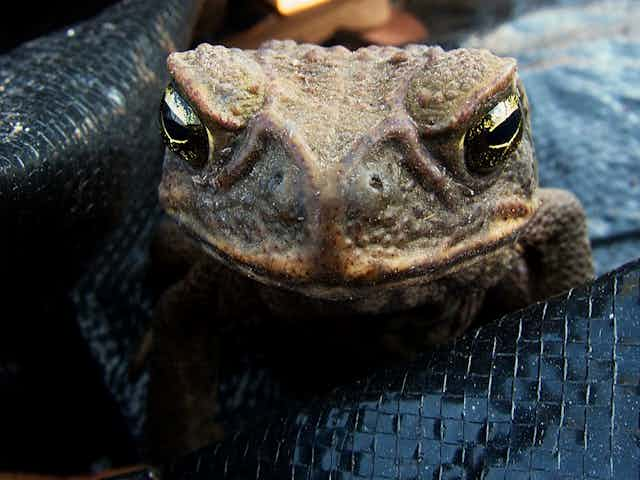Cane toads are one of the Australia’s most serious invasive species, killing predators such as goannas, quolls and crocodiles in the tropical north. We already know the toads are advancing from Queensland to the Kimberley. New research shows the toads may evolve to spread faster in new environments. But this may be good news for animals who have to move because of climate change.
So, how do we get from toads to climate?
Hopping to it
Most ecological theory starts with the assumption that a population of animals is stable in space: individuals and their offspring live in the same general area year after year. But, the reality is much messier: many populations are not stable. For example, invasive species expand their range as they spread.
As part of a long-term study by my University of Sydney-based “Team Bufo”, Greg Brown radio-tracked invasive cane toads as they first arrived at an area near Darwin, and continued to track newly-arriving toads over the next several years. Tom Lindstrom’s mathematical analysis of those radio-tracking results revealed a dramatic shift, published today in the journal PNAS.
The first toads that arrived near Darwin were incredibly mobile, often moving more than one kilometre within a single night – but within a couple of years that rate had more than halved. The super-speediness seen at the invasion front is probably driven by evolutionary forces that come into play only at an expanding range edge, and are not seen in stable populations. Earlier studies on the toad front had revealed these mechanisms, and the current work shows just how spectacular the acceleration can be.
That rapid decrease in mobility after the invasion front passes through means that studies on “normal” cane toads – that is, on animals from long-established populations – would underestimate the potential rate of movement. If we want to predict how quickly a species can expand its range, we need to look right at the expanding range edge.
Unfortunately, that’s logistically difficult, so most of our data on animal dispersal rates come from long-established, stable populations. As a result, we may be underestimating potential rates of population spread.
Adapting to a changing world
The problem doesn’t just relate to invasive species. Many species shift their ranges for other reasons. Climate change is rendering many areas unsuitable for the animals and plants that currently live there (for example, by becoming too hot or too dry). But at the same time it is creating those conditions somewhere nearby (in an area that previously may have been too cold or too wet).
If a species caught in this situation is to survive, individuals either must rapidly adapt to the new conditions, or move to the area that offers suitable conditions. The fast pace of climate change makes both of these options very tough to achieve, but not impossible.
Even in a species where individuals generally do not move about very much or very far, the process of expanding their range into a newly-suitable area will create an evolutionary pressure for faster and faster dispersal. The end result may be that many species will manage to shift their distributions more quickly than we would have guessed from the movement rates we can measure in existing stable populations. And perhaps that provides a glimmer of hope.

